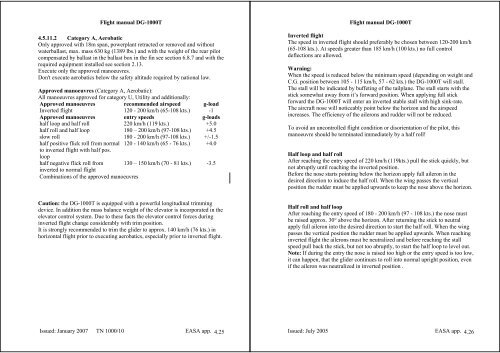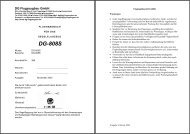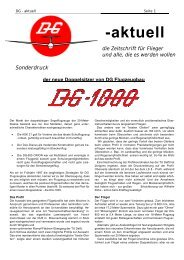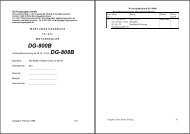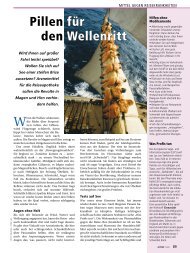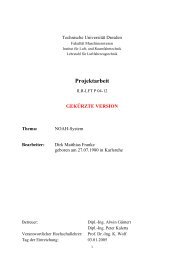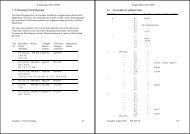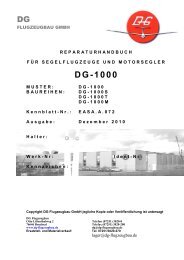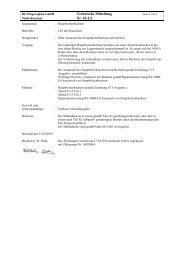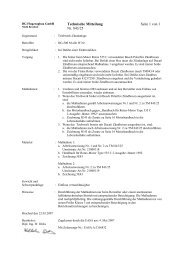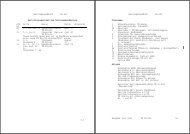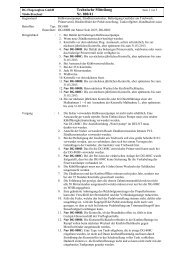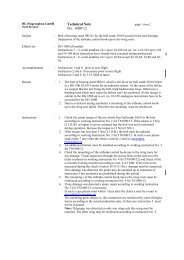DG-1000T - DG Flugzeugbau
DG-1000T - DG Flugzeugbau
DG-1000T - DG Flugzeugbau
Create successful ePaper yourself
Turn your PDF publications into a flip-book with our unique Google optimized e-Paper software.
Flight manual <strong>DG</strong>-<strong>1000T</strong><br />
4.5.11.2 Category A, Aerobatic<br />
Only approved with 18m span, powerplant retracted or removed and without<br />
waterballast, max. mass 630 kg (1389 lbs.) and with the weight of the rear pilot<br />
compensated by ballast in the ballast box in the fin see section 6.8.7 and with the<br />
required equipment installed see section 2.13.<br />
Execute only the approved manoeuvres.<br />
Don't execute aerobatics below the safety altitude required by national law.<br />
Approved manoeuvres (Category A, Aerobatic):<br />
All manoeuvres approved for category U, Utility and additionally:<br />
Approved manoeuvres recommended airspeed g-load<br />
Inverted flight 120 - 200 km/h (65-108 kts.) -1<br />
Approved manoeuvres entry speeds g-loads<br />
half loop and half roll 220 km/h (119 kts.) +5.0<br />
half roll and half loop 180 – 200 km/h (97-108 kts.) +4.5<br />
slow roll 180 - 200 km/h (97-108 kts.) +/-1.5<br />
half positive flick roll from normal 120 - 140 km/h (65 - 76 kts.)<br />
to inverted flight with half pos.<br />
loop<br />
+4.0<br />
half negative flick roll from<br />
inverted to normal flight<br />
130 – 150 km/h (70 - 81 kts.) -3.5<br />
Combinations of the approved manoeuvres<br />
Caution: the <strong>DG</strong>-<strong>1000T</strong> is equipped with a powerful longitudinal trimming<br />
device. In addition the mass balance weight of the elevator is incorporated in the<br />
elevator control system. Due to these facts the elevator control forces during<br />
inverted flight change considerably with trim position.<br />
It is strongly recommended to trim the glider to approx. 140 km/h (76 kts.) in<br />
horizontal flight prior to executing aerobatics, especially prior to inverted flight.<br />
Issued: January 2007 TN 1000/10 EASA app. 4.25<br />
Flight manual <strong>DG</strong>-<strong>1000T</strong><br />
Inverted flight<br />
The speed in inverted flight should preferably be chosen between 120-200 km/h<br />
(65-108 kts.). At speeds greater than 185 km/h (100 kts.) no full control<br />
deflections are allowed.<br />
Warning:<br />
When the speed is reduced below the minimum speed (depending on weight and<br />
C.G. position between 105 - 115 km/h, 57 - 62 kts.) the <strong>DG</strong>-<strong>1000T</strong> will stall.<br />
The stall will be indicated by buffeting of the tailplane. The stall starts with the<br />
stick somewhat away from it’s forward position. When applying full stick<br />
forward the <strong>DG</strong>-<strong>1000T</strong> will enter an inverted stable stall with high sink-rate.<br />
The aircraft nose will noticeably point below the horizon and the airspeed<br />
increases. The efficiency of the ailerons and rudder will not be reduced.<br />
To avoid an uncontrolled flight condition or disorientation of the pilot, this<br />
manoeuvre should be terminated immediately by a half roll!<br />
Half loop and half roll<br />
After reaching the entry speed of 220 km/h (119kts.) pull the stick quickly, but<br />
not abruptly until reaching the inverted position.<br />
Before the nose starts pointing below the horizon apply full aileron in the<br />
desired direction to induce the half roll. When the wing passes the vertical<br />
position the rudder must be applied upwards to keep the nose above the horizon.<br />
Half roll and half loop<br />
After reaching the entry speed of 180 - 200 km/h (97 - 108 kts.) the nose must<br />
be raised approx. 30° above the horizon. After returning the stick to neutral<br />
apply full aileron into the desired direction to start the half roll. When the wing<br />
passes the vertical position the rudder must be applied upwards. When reaching<br />
inverted flight the ailerons must be neutralized and before reaching the stall<br />
speed pull back the stick, but not too abruptly, to start the half loop to level out.<br />
Note: If during the entry the nose is raised too high or the entry speed is too low,<br />
it can happen, that the glider continues to roll into normal upright position, even<br />
if the aileron was neutralized in inverted position .<br />
Issued: July 2005 EASA app. 4.26


